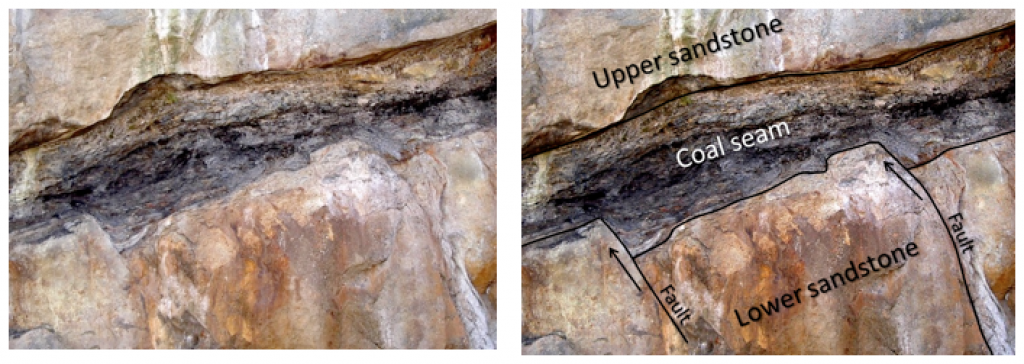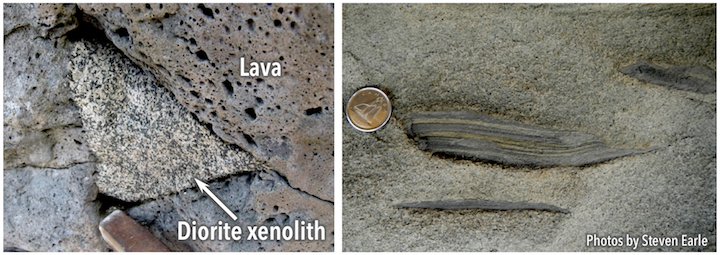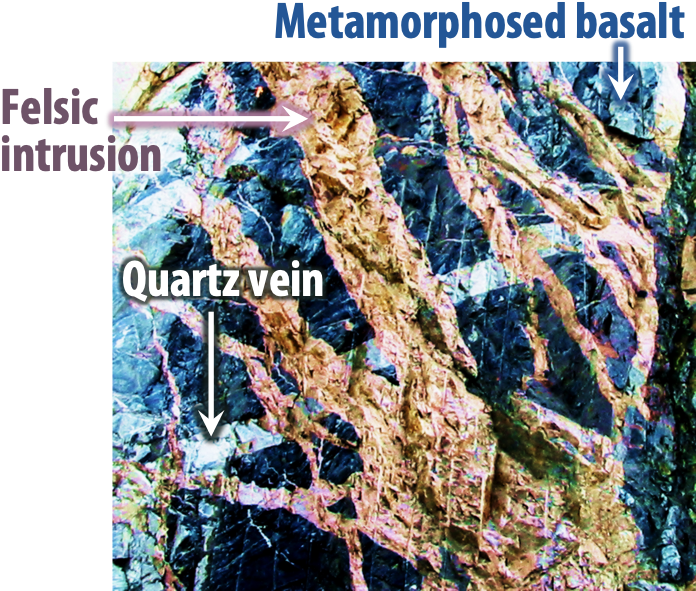19.2 Relative Dating Methods
Relative Dating Principles
The most basic way of dating geological features is to look at the relationships between them. There are a few simple rules for doing this, but caution must be taken because there may be situations in which the rules are not valid. Local factors must be understood before an interpretation can be made with confidence. These situations are generally rare, but they should not be forgotten when unraveling the geological history of an area.
The principle of superposition states that sedimentary layers are deposited in sequence, and the layers at the bottom are older than those at the top. The exception is if the sequence of rocks has been flipped completely over by tectonic processes, or disrupted and re-stacked by faulting.
The principle of original horizontality indicates that sediments are originally deposited as horizontal to nearly horizontal sheets. The exception happens on small scales, like cross-beds which form at an angle to the main bedding surfaces. The same is true of delta foreset beds (Figure 19.6).

The principle of lateral continuity states that sediments are deposited such that they extend sideways for some distance before thinning and pinching out at the edge of the depositional basin. But sediments can also terminate against faults or erosional features (see unconformities below), and so may be cut off by local factors. The main idea here is that sedimentary layers don’t just stop abruptly for no reason.
The principle of cross-cutting relationships states that any geological feature that cuts across or disrupts another feature must be younger than the feature that is disrupted. An example of this is given in Figure 19.7, which shows three different sedimentary layers. The lower sandstone layer is disrupted by two faults, so we can infer that the faults are younger than this layer. But the faults don’t appear to continue into the coal seam, and they certainly don’t continue into the upper sandstone. So we can infer that coal seam is younger than the faults (because the coal seam cuts across them). The upper sandstone is youngest of all, because it lies on top of the coal seam.

An example that violates this principle is a type of fault called a growth fault, where the fault continues to move as sediments are added on top of the hangingwall block. In this case, the lower portion of the fault that cuts the lower sediments may have originally formed before the uppermost sediments were deposited, despite the fault cutting through all of the sediments, and appearing to be entirely younger than all of the sediments.
The next three principles could be considered specific varieties of the principle of cross-cutting relationships, because they involve one geological feature disrupting another in some way.
The principle of inclusions states that any rock fragments that are included in a rock must be older than the rock in which they are included. For example, a xenolith in an igneous rock, or a clast in sedimentary rock must be older than the rock that includes it (Figure 19.8).

A possible situation that would violate this principle is a scenario where an igneous dyke intrudes through a sequence of rocks, and hence is younger than these rocks (principle of cross-cutting relationships). Later deformation may cause the dyke to be pulled apart into small pieces, and surrounded by the host rocks. That would make the pieces of the dyke appear to be xenoliths, but they would be younger than the surrounding rock.
The principle of baked contacts states that the heat of an intrusion will bake (metamorphose) the rocks in close proximity to the intrusion. Hence the presence of a baked contact indicates the intrusion is younger than the rocks around it. If an intrusive igneous rock is exposed via erosion, then later buried by sediments, the surrounding rocks will not be baked, as the intrusion was already cold at the time of sediment deposition. But baked contacts may be difficult to discern, or may be minimally developed to absent when the intrusive rocks are low in volume or felsic (relatively cool) in composition.
The principle of chilled margins states that the portion of an intrusion that has cooled and crystallized next to cold surrounding rock will form smaller crystals than the portion of the intrusion that cooled more slowly deeper in the instrusion. Smaller crystals generally appear darker in colour than larger crystals, so a chilled margin appears as a darkening of the intrusive rock towards the surrounding rock. This principle can be used to distinguish between an igneous sill, which will have a chilled margin at top and bottom, and a lava flow, which will have a chilled margin only at the bottom.
Practice with Relative Dating Principles
Type the correct stratigraphic principle.
- Sedimentary layers are deposited in sequence, so the oldest layers are on the bottom.
- Sediments are originally deposited as horizontal to nearly horizontal sheets.
- Sediments extend sideways for some distance unless they’re cut off by something like a fault or erosion.
- Xenoliths are always older than the rock containing them. (hint: this is a specific type of one of the other principles.)
- A geological feature that disrupts another geological feature is the younger of the two.
- If rocks around an intrusion are altered by contact metamorphism, the rocks are older than the intrusion. (hint: this is a specific type of one of the other principles.)
- If the edges of an intrusion cool off quickly, the intrusion is younger than the rock to which it lost its heat. (hint: this is a specific type of the other principles.)
Fill-in-the-blank options:
- horizontality
- cross-cutting
- superposition
- inclusions
- baked contacts
- lateral continuity
- chilled margins
To check your answers, navigate to the below link to view the interactive version of this activity.
Now that you’re warmed up, try this:

- This outcrop has three rock types. What principle will you use to figure out their relative ages? (Hint: Notice which layers are interrupted.)
- List the rock types according to the principle of superposition.
Write down your answers before reading the explanation below:
- Cross-cutting relationships tell us the relative ages of the three elements in this outcrop.
- The basalt is cut by both the felsic intrusion and the quartz vein, so it has to be the oldest. If it’s metamorphosed because of the felsic intrusion, that would be another way to help infer its relative age.
- The felsic intrusion also cuts the quartz vein, so it had to come after the quartz formed.
Unconformities
An unconformity represents an interruption in the process of deposition of sediments. Recognizing unconformities is important for understanding time relationships in sedimentary sequences. An unconformity is visible in the Grand Canyon (Figure 19.9, white dashed line) above Proterozoic rocks that were tilted and then eroded to a flat surface prior to deposition of the younger Paleozoic rocks. The difference in time between the youngest of the Proterozoic rocks and the oldest of the Paleozoic rocks is nearly 300 million years. Tilting and erosion of the older rocks took place during this time, and if there were any deposition occurring in this area during this time, erosion removed those sediments.

There are four types of unconformities, reflecting different arrangements and types of rocks above and below the surface of non-deposition or erosion (Figure 19.10):
- A nonconformity (Figure 19.10a) is a boundary with non-sedimentary rocks below, and sedimentary rocks above.
- An angular unconformity (Figure 19.10b) is a boundary between two sequences of sedimentary rocks, where underlying units have been tilted or folded and eroded before the younger units were deposited.
- A disconformity (Figure 19.10c) is a boundary between two sequences of sedimentary rocks, where the underlying units have been eroded but not tilted or deformed before the younger layers were deposited.
- A paraconformity is a time gap in a sequence of sedimentary rocks related to non-deposition rather than erosion. The gap won’t be visible as an angular unconformity or a disconformity.


